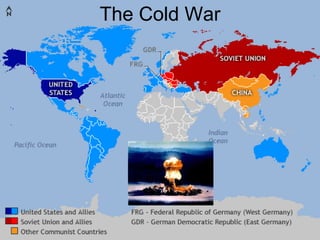The Cold War was a period of tension and conflict between the US and USSR that began after WWII and lasted until the fall of communism in the Soviet Union in the early 1990s. Key events included the division of Germany and Berlin, the Truman Doctrine providing aid to Greece and Turkey to resist communism, and the failure of containment in Vietnam where North and South Vietnam were united under a communist government. The collapse of communism in Eastern Europe in the late 1980s led to the reunification of Germany and the dissolution of the Soviet Union in 1991, bringing the Cold War to an end.





























































